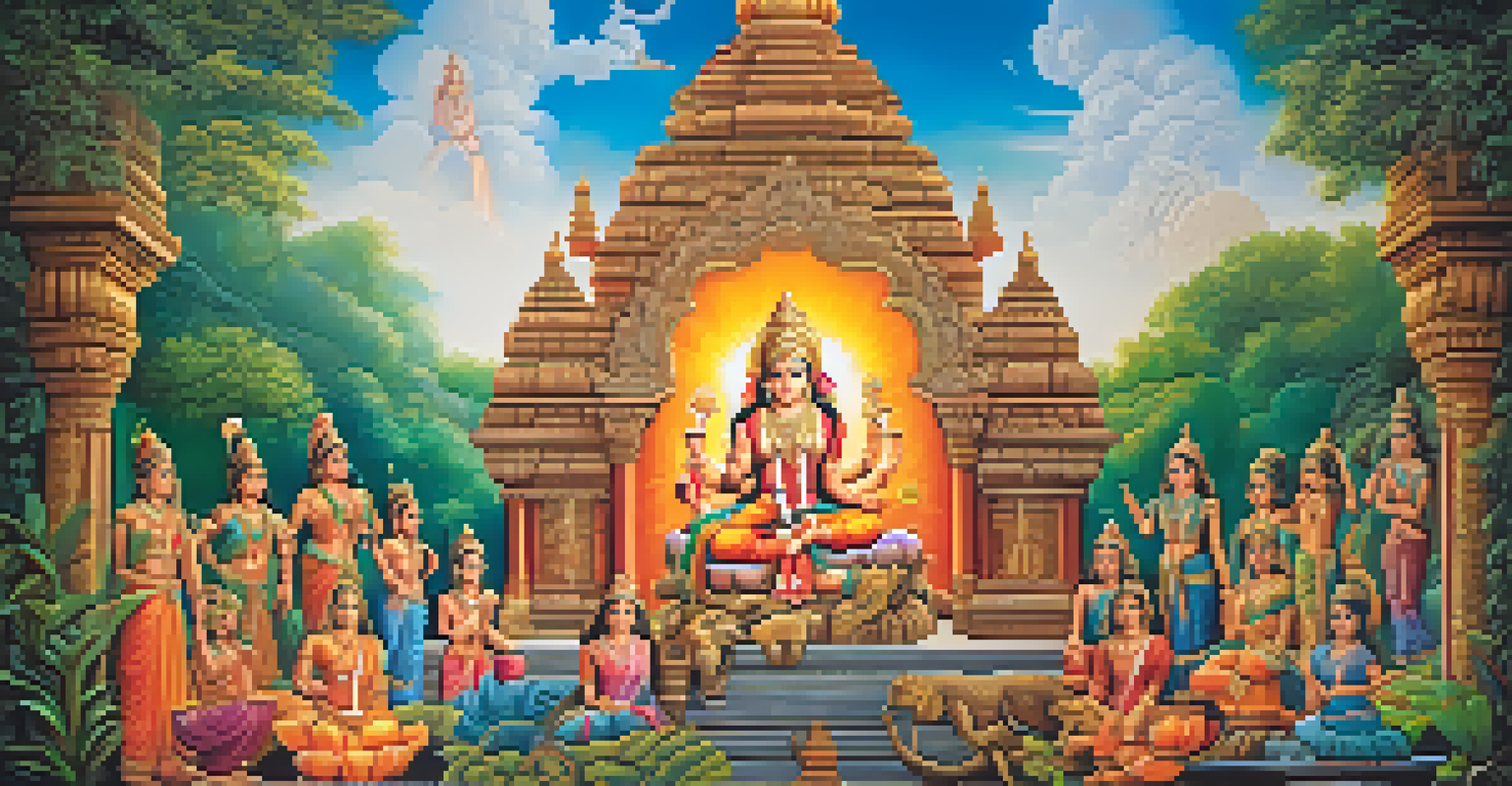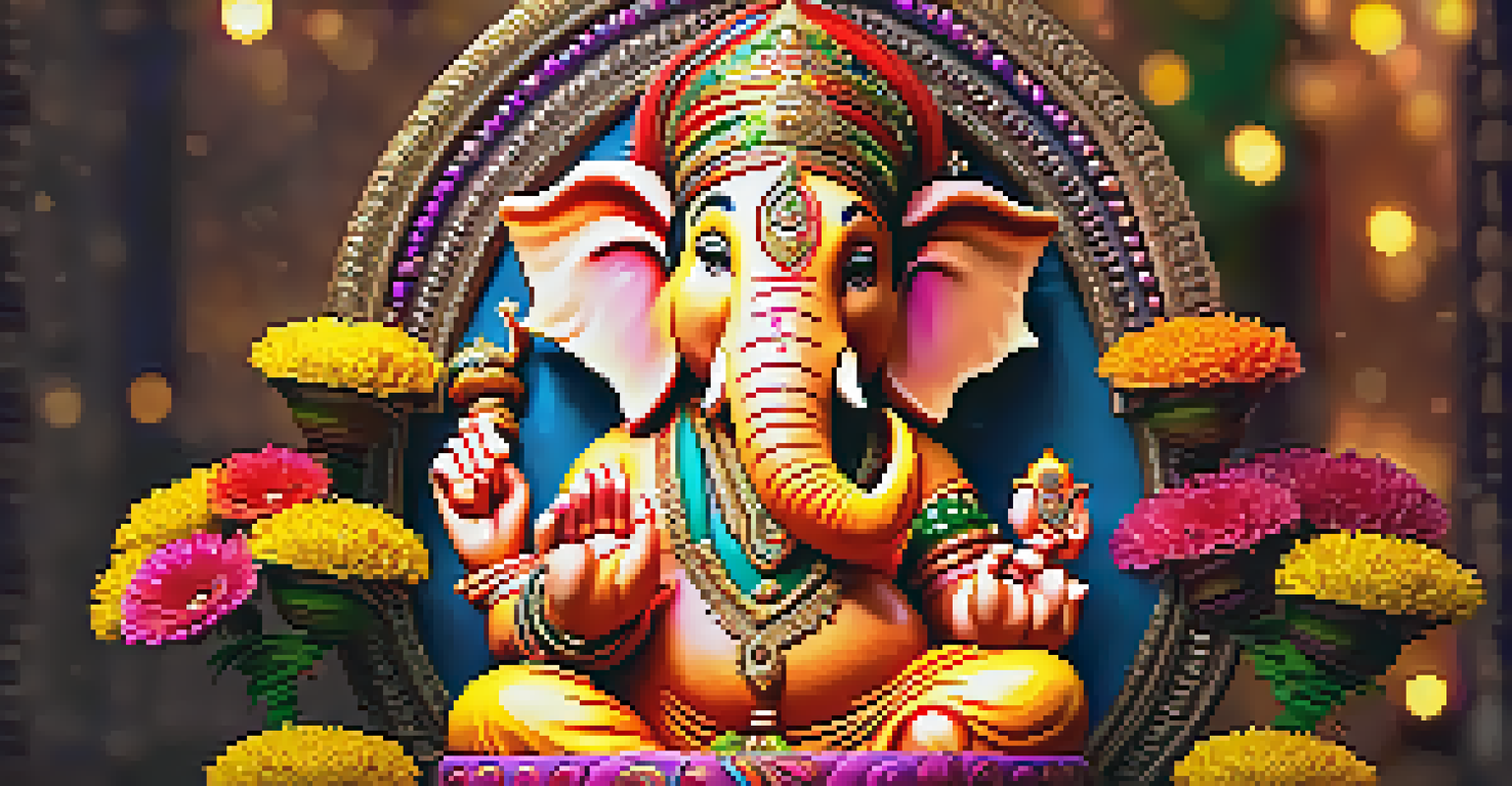Artistic Expressions in Hindu Religious Festivals

The Vibrant Tapestry of Hindu Festivals
Hindu festivals are a colorful celebration of faith, culture, and community. Each festival is marked by unique traditions that showcase the rich heritage of Hinduism. From Diwali’s dazzling lights to Holi’s vibrant colors, these events are a feast for the senses and a canvas for artistic expression.
Art enables us to find ourselves and lose ourselves at the same time.
Art plays a crucial role in these celebrations, transforming public spaces into lively hubs of creativity. Decorations, rangolis, and intricate sculptures reflect the stories and deities revered during these festivals. As such, art becomes a medium not just for decoration, but also for storytelling and cultural preservation.
Moreover, these artistic expressions foster a sense of belonging and unity among participants. They encourage community involvement, as families and friends come together to create and celebrate, weaving personal narratives into the broader tapestry of Hindu culture.
Rangoli: An Art of Colorful Patterns
Rangoli, a traditional Indian art form, is commonly seen during Hindu festivals, especially Diwali. Made from colored powders, flowers, or rice, these intricate designs are created at the entrance of homes to welcome guests and deities. This art form is not just decorative; it symbolizes prosperity and good fortune.

Creating rangoli is often a family affair, with everyone contributing their creativity. The designs can be simple geometric shapes or elaborate motifs depicting nature and mythology. This aspect of rangoli highlights the communal spirit of Hindu festivals, as families gather to plan and execute their designs.
Hindu Festivals Celebrate Community
Hindu festivals foster a sense of belonging through vibrant artistic expressions that unite families and communities.
Moreover, the act of creating rangoli encourages mindfulness and patience. Each stroke and color choice is a reflection of the creator's personality and intentions, making every piece a unique expression of art and devotion.
The Role of Music and Dance in Celebrations
Music and dance are integral elements of Hindu festivals, enhancing the celebratory atmosphere. Traditional forms such as Bharatanatyam and Kathak are often performed during religious ceremonies, bringing stories of gods and goddesses to life. These performances are not only entertaining but also deeply spiritual.
The essence of all beautiful art, all great art, is gratitude.
The rhythmic beats and melodious tunes evoke emotions that resonate with the audience, drawing them into the festive spirit. This connection between performer and spectator reinforces community bonds, as people come together to share in the experience. In essence, music and dance serve as a bridge linking the divine with the earthly.
Moreover, these art forms often reflect the cultural diversity within Hinduism. Different regions have their own musical styles and dance forms, showcasing the rich tapestry of traditions that exist within the religion. This variety adds depth to the celebrations, making each festival a unique cultural experience.
Festive Decorations: A Canvas of Devotion
During Hindu festivals, homes and public spaces are adorned with elaborate decorations that reflect devotion and joy. Colorful lights, flowers, and fabrics transform ordinary spaces into vibrant expressions of faith. These decorations play a significant role in setting the mood for the celebrations.
The choice of decorations often symbolizes various aspects of Hindu beliefs. For instance, marigold flowers are commonly used during weddings and festivals, as they are believed to bring good luck. This thoughtful selection of decorative elements connects the physical space to the spiritual significance of the occasion.
Art as Cultural Preservation
Artistic practices during festivals play a crucial role in preserving Hindu cultural heritage and transmitting values to future generations.
Additionally, festive decorations encourage creativity and personal expression. Families often take pride in showcasing their unique styles, whether through traditional or contemporary designs. This blend of personal and cultural elements creates a rich visual experience that resonates with everyone involved.
The Art of Storytelling Through Murals
Murals are a powerful artistic expression found in many Hindu festivals, especially in rural areas. These large-scale paintings often depict mythological stories, historical events, or scenes from religious texts. They serve as both decoration and a means of educating the community about their cultural heritage.
Creating murals is typically a collective effort, bringing together artists and community members. This collaboration fosters a sense of pride and ownership, as everyone contributes to the visual narrative of their shared beliefs. The murals often become a source of inspiration and reflection for those who view them.
Furthermore, these artworks are not static; they evolve over time. New layers of paint and stories are added as generations pass, making each mural a living testament to the community’s evolving identity and values. This dynamic nature of murals reinforces the idea that art is a continuous dialogue between the past, present, and future.
Sculptures: Capturing Divine Presence
Sculpture is a prominent form of artistic expression during Hindu festivals, with intricate idols of deities taking center stage. These sculptures are meticulously crafted from various materials, including clay, wood, and metal. The artistry involved reflects the devotion and reverence of the artisans who create them.
During festivals like Ganesh Chaturthi, elaborate idols of Lord Ganesha are installed in homes and public spaces. These sculptures serve as focal points for worship, drawing people together in prayer and celebration. The process of sculpting and immersing these idols in water after the festival symbolizes the cycle of creation and dissolution.
Diverse Artistic Expressions
From rangoli to sculptures, the diverse forms of art in Hindu festivals enhance spiritual connections and celebrate regional traditions.
Moreover, the craftsmanship of these idols often tells a story in itself. Each detail, from the facial expressions to the positioning of limbs, carries symbolic meaning. This attention to detail not only enhances the beauty of the sculptures but also deepens the spiritual connection for devotees.
The Importance of Cultural Preservation
Artistic expressions in Hindu festivals play a critical role in preserving cultural heritage. By engaging in these practices, communities connect with their history and transmit values to future generations. This cultural continuity is vital for maintaining the rich tapestry of Hindu traditions.
As globalization influences societies, preserving these artistic forms becomes even more important. Festivals provide an opportunity for individuals to engage with their roots, fostering a sense of identity and belonging. This connection to one’s heritage helps navigate the complexities of modern life while honoring the past.

Additionally, cultural preservation through art encourages innovation. Artists often blend traditional techniques with contemporary styles, creating new forms of expression that resonate with younger audiences. This fusion ensures that the artistic legacy of Hindu festivals remains vibrant and relevant.
Conclusion: The Enduring Legacy of Artistic Expressions
The artistic expressions found in Hindu religious festivals are more than mere decorations or performances; they are vital components of cultural identity and spirituality. They encapsulate the rich heritage of Hinduism while also adapting to the changing times. Each festival becomes a living gallery of art, creativity, and community.
Through rangoli, music, dance, murals, and sculptures, participants experience a profound connection to their faith and each other. These artistic expressions foster unity, joy, and reflection, enriching the festival experience for everyone involved. They remind us that art is a powerful vehicle for storytelling and spiritual connection.
As we celebrate these vibrant traditions, it is essential to recognize and honor the artists who contribute to this legacy. Their creativity and dedication ensure that the beauty of Hindu festivals continues to inspire and bring people together for generations to come.